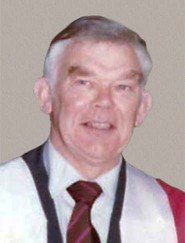

Professor James Gibson retired from the University on April 2, 1983. He held the Chair of Pathology from 1963 until retirement and was for several years the University's senior professor. He served as Dean of Medicine for six years, from 1972 to 1978, and as Pro-Vice-Chancellor for two separate periods. His contributions to the University as a whole and to the Department of Pathology in particular have been immense and his influence will be felt for years to come.
Educated at Dundee High School then Fettes College, Edinburgh, he won an entrance bursary to the University of Edinburgh where he studied the classics (a more common preliminary to medical studies in those days than now!). In 1941, at the height of World War II, he travelled to America as a Rockefeller student to study medicine at Western Reserve University, Cleveland. In 1943 he graduated with the degrees of MD from Western Reserve and MB,ChB from the University of Edinburgh. Only a few months later he joined the Royal Navy in which he served for two and a half years as a Surgeon Lieutenant. In this capacity he was part of one of the great historic events of this century, the Normandy Landing; his ship was stationed off Omaha Beach where some of the worst carnage was suffered by the American troops. There is little doubt that the disciplines of navy life taught him much of value which he carried into his later professional life.
In 1946 he entered the Department of Pathology, University of Glasgow. He must have developed a certain liking for Glasgow, because he remained there for seven years (Glasgow, he has hinted, is the Hong Kong of Scotland). In 1954 he was appointed Lecturer in Pathology at Queen's University, Belfast where he rose to consultant status. He gained his MD "with high commendation" from the University of Edinburgh in 1958. Two more years, 1960 and 1961, were spent at Western Reserve as a Visiting Professor and soon after that, in 1963, he was appointed to the Chair of Pathology in this University. In his inaugural lecture Professor Gibson said "medicine without the audit of pathology is medicine neglectful of standards" and he quoted Confucius: "If when I give the student one corner of the subject he cannot find the other three for himself, I do not repeat my lesson". In clinical service and teaching, he took these principles and put them into practice with energy and determination. It is indeed a daunting task to try to summarise his main achievements over the span of twenty years, but they would appear to be in the following three areas: pathology services, technician training, and postgraduate teaching and training of young pathologists.
It is hard to imagine that in 1963 Pathology had a professional staff of about half a dozen; now there are approximately thirty. The Clinical Pathology Building stands as a monument to the upgrading and expansion of the Queen Mary Hospital laboratory services, funded by an annual government subvention but administered through the University. Professor Gibson did almost all the detailed internal planning of this new building, opened in 1972; the standard and scope of laboratory services within it have continued to improve steadily since then so that now, without question, they are unrivalled in Hong Kong.
Soon after taking up his post in Hong Kong, Professor Gibson was made Chairman of the Management Committee of Extra-mural Studies and from this vantage point he pioneered the in-service training of medical laboratory technicians, which led to the establishment of the Ordinary Technician Certificate and Higher Technician Certificate courses (equivalent to Ordinary National Certificate and Higher National Certificate in the UK) and eventually facilitated the passage of an Ordinance to regulate the practice of Medical Laboratory Technology in Hong Kong (Supplementary Medical Professions Bill, 1980). Places in these courses are highly sought after and have contributed to the continued improvement in laboratory services in government, subvented and private hospitals throughout Hong Kong. When he became Dean of Medicine, Professor Gibson recognised clearly the need to develop postgraduate medical teaching throughout Hong Kong. He was the prime mover in establishing the Unit of Postgraduate Medical Education and, subsequently, in the setting up of the Hong Kong University/China Medical Board Fellowship Scheme. Through this scheme, 108 Fellows from Southeast Asia have studied in Hong Kong and it was particularly pleasing to Professor Gibson that, in the last two years, it has proved possible to offer Fellowships to teachers in medical schools in China. He also played a major role in establishing the Licentiate Committee system (through the initiation of the Holmes Report) for the local qualification of graduates from Mainland China. By his own admission, Professor Gibson gained most satisfaction from the training of young pathologists. He regarded Pathology as the centrepiece and the logical basis of medical science. Armed with this philosophy, and with a thorough period of training behind them, his junior staff, almost without exception, have succeeded in their specialist examinations. James Gibson has an impressive range of appointments, memberships of professional associations, external examinerships and medical consultancies. He has approximately sixty publications to his credit and was principal author of the WHO book Histological Typing of Tumours of the Liver, Biliary Tract and Pancreas (1978). In 1976 the Queen awarded him the OBE. Outside medicine he had wide-ranging interests (as a squash player, his skill was surpassed only by his ferocious demeanour). His favourite pastime is undoubtedly hill-walking which he will be able to enjoy to the full during his retirement in the highlands of bonny Scotland.
Citation written and delivered by Professor Peter Bernard Harris, the Public Orator of the University.



